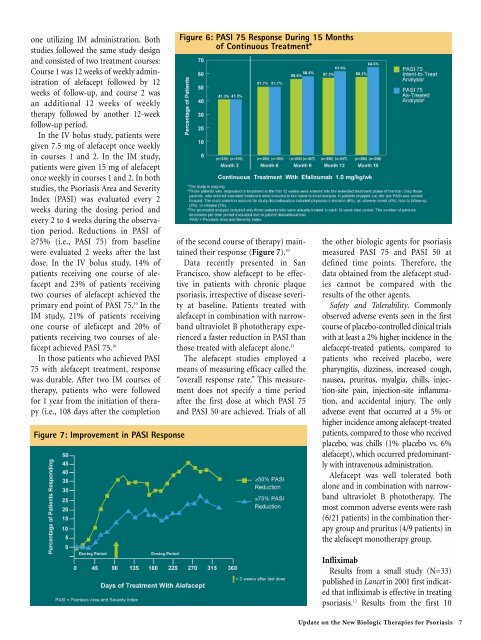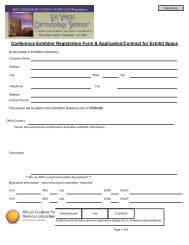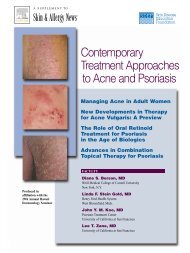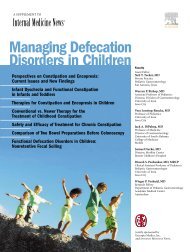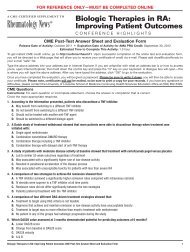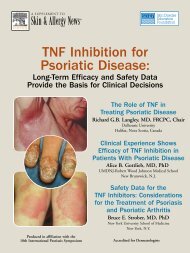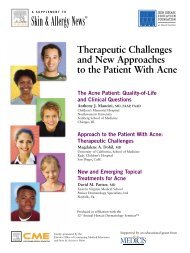Overview Of Psoriasis - Global Academy for Medical Education
Overview Of Psoriasis - Global Academy for Medical Education
Overview Of Psoriasis - Global Academy for Medical Education
You also want an ePaper? Increase the reach of your titles
YUMPU automatically turns print PDFs into web optimized ePapers that Google loves.
one utilizing IM administration. Both<br />
studies followed the same study design<br />
and consisted of two treatment courses:<br />
Course 1 was 12 weeks of weekly administration<br />
of alefacept followed by 12<br />
weeks of follow-up, and course 2 was<br />
an additional 12 weeks of weekly<br />
therapy followed by another 12-week<br />
follow-up period.<br />
In the IV bolus study, patients were<br />
given 7.5 mg of alefacept once weekly<br />
in courses 1 and 2. In the IM study,<br />
patients were given 15 mg of alefacept<br />
once weekly in courses 1 and 2. In both<br />
studies, the <strong>Psoriasis</strong> Area and Severity<br />
Index (PASI) was evaluated every 2<br />
weeks during the dosing period and<br />
every 2 to 4 weeks during the observation<br />
period. Reductions in PASI of<br />
≥75% (i.e., PASI 75) from baseline<br />
were evaluated 2 weeks after the last<br />
dose. In the IV bolus study, 14% of<br />
patients receiving one course of alefacept<br />
and 23% of patients receiving<br />
two courses of alefacept achieved the<br />
primary end point of PASI 75. 10 In the<br />
IM study, 21% of patients receiving<br />
one course of alefacept and 20% of<br />
patients receiving two courses of alefacept<br />
achieved PASI 75. 10<br />
In those patients who achieved PASI<br />
75 with alefacept treatment, response<br />
was durable. After two IM courses of<br />
therapy, patients who were followed<br />
<strong>for</strong> 1 year from the initiation of therapy<br />
(i.e., 108 days after the completion<br />
Figure 7: Improvement in PASI Response<br />
Figure 6: PASI 75 Response During 15 Months<br />
of Continuous Treatment*<br />
of the second course of therapy) maintained<br />
their response (Figure 7). 10<br />
Data recently presented in San<br />
Francisco, show alefacept to be effective<br />
in patients with chronic plaque<br />
psoriasis, irrespective of disease severity<br />
at baseline. Patients treated with<br />
alefacept in combination with narrowband<br />
ultraviolet B phototherapy experienced<br />
a faster reduction in PASI than<br />
those treated with alefacept alone. 11<br />
The alefacept studies employed a<br />
means of measuring efficacy called the<br />
“overall response rate.” This measurement<br />
does not specify a time period<br />
after the first dose at which PASI 75<br />
and PASI 50 are achieved. Trials of all<br />
the other biologic agents <strong>for</strong> psoriasis<br />
measured PASI 75 and PASI 50 at<br />
defined time points. There<strong>for</strong>e, the<br />
data obtained from the alefacept studies<br />
cannot be compared with the<br />
results of the other agents.<br />
Safety and Tolerability. Commonly<br />
observed adverse events seen in the first<br />
course of placebo-controlled clinical trials<br />
with at least a 2% higher incidence in the<br />
alefacept-treated patients, compared to<br />
patients who received placebo, were<br />
pharyngitis, dizziness, increased cough,<br />
nausea, pruritus, myalgia, chills, injection-site<br />
pain, injection-site inflammation,<br />
and accidental injury. The only<br />
adverse event that occurred at a 5% or<br />
higher incidence among alefacept-treated<br />
patients, compared to those who received<br />
placebo, was chills (1% placebo vs. 6%<br />
alefacept), which occurred predominantly<br />
with intravenous administration.<br />
Alefacept was well tolerated both<br />
alone and in combination with narrowband<br />
ultraviolet B phototherapy. The<br />
most common adverse events were rash<br />
(6/21 patients) in the combination therapy<br />
group and pruritus (4/9 patients) in<br />
the alefacept monotherapy group.<br />
Infliximab<br />
Results from a small study (N=33)<br />
published in Lancet in 2001 first indicated<br />
that infliximab is effective in treating<br />
psoriasis. 12 Results from the first 10<br />
Update on the New Biologic Therapies <strong>for</strong> <strong>Psoriasis</strong> 7


